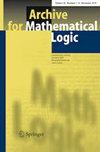苏斯林树及其属枝的刚性
IF 0.3
4区 数学
Q1 Arts and Humanities
引用次数: 2
摘要
我们证明有一个苏斯林树S是一致的,在用S强迫之后,S是Kurepa,对于所有俱乐部\(C \subset \omega _1\), \(S\upharpoonright C\)是刚性的。这回答了Fuchs (Arch Math Logic 52(1-2): 47-66, 2013)中的问题。此外,我们证明了与\(\diamondsuit \)一致的是,对于每个苏斯林树T,存在一个不包含T副本的稠密\(X \subseteq T\)。这与Baumgartner (Ordered sets (Banff, Alta)中的Baumgartner(有序集)问题有关。(1981年),《北约高级研究研究所》第83卷。C:数学。物理。科学。, Reidel, Dordrecht-Boston, pp 239-277, 1982)。本文章由计算机程序翻译,如有差异,请以英文原文为准。
On the rigidity of Souslin trees and their generic branches
We show it is consistent that there is a Souslin tree S such that after forcing with S, S is Kurepa and for all clubs \(C \subset \omega _1\), \(S\upharpoonright C\) is rigid. This answers the questions in Fuchs (Arch Math Logic 52(1–2):47–66, 2013). Moreover, we show it is consistent with \(\diamondsuit \) that for every Souslin tree T there is a dense \(X \subseteq T\) which does not contain a copy of T. This is related to a question due to Baumgartner in Baumgartner (Ordered sets (Banff, Alta., 1981), volume 83 of NATO Adv. Study Inst. Ser. C: Math. Phys. Sci., Reidel, Dordrecht-Boston, pp 239–277, 1982).
求助全文
通过发布文献求助,成功后即可免费获取论文全文。
去求助
来源期刊

Archive for Mathematical Logic
MATHEMATICS-LOGIC
CiteScore
0.80
自引率
0.00%
发文量
45
审稿时长
6-12 weeks
期刊介绍:
The journal publishes research papers and occasionally surveys or expositions on mathematical logic. Contributions are also welcomed from other related areas, such as theoretical computer science or philosophy, as long as the methods of mathematical logic play a significant role. The journal therefore addresses logicians and mathematicians, computer scientists, and philosophers who are interested in the applications of mathematical logic in their own field, as well as its interactions with other areas of research.
 求助内容:
求助内容: 应助结果提醒方式:
应助结果提醒方式:


